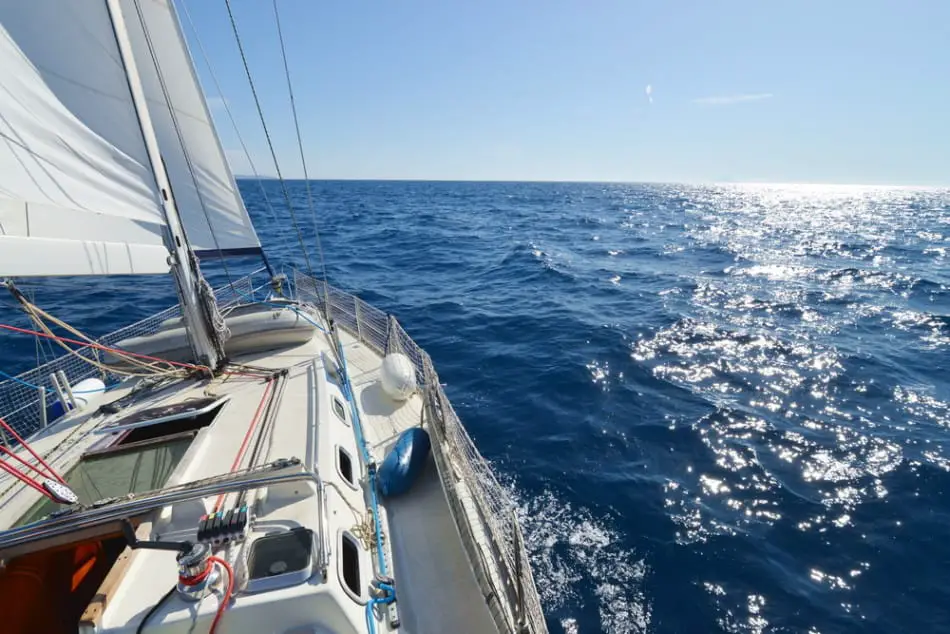Circumnavigating the globe on a sailboat or yacht is an enormous undertaking, and making sure that you will be welcomed in all the ports on your planned route will require some detailed planning. The documentation required may vary from country to country, but great sailing guides are published in book form and online to help you.
You do not need a license to sail your own seaworthy sailboat around the world. Charter companies require proof of competence before they allow you to sail their boats due to the nautical insurance company requirements. Certain licenses and certificates of competence will make your dream easier.
Regular cruisers agree that obtaining comprehensive insurance for your sailboat is quite a daunting task. Insurers want to see proof that you are capable and experienced enough to sail your yacht around the world. Let’s look at all the aspects required to satisfy insurers of your competency and preparedness for circumnavigation.
Documents Needed For Circumnavigating By Sail Boat
Sailing around the world on your yacht is one of the most daunting adventures possible. The risk of loss of life and your yacht is high, and the consequence of error can bankrupt you if you are not well prepared and have the required experience and sailing credentials to limit the risk.
Preparing your yacht for sailing around the world will entail the installation and registration of Emergency Position Indicating Radio Beacons (EPIRB) that will allow the position of your vessel to be tracked via global satellite tracking. The EPIRB will also make you visible to ships and the nearest coast guard stations in your immediate vicinity.
You will also need to install and license your Very High Frequency (VHF) radio communications system. The VHF radio is a powerful communication device that will allow you to receive weather system updates and communicate with port authorities and other vessels in your area. Your VHF Radio and the EPIRB system back each other up in the event of distress.
Planning your route is critical in identifying all the ports of call and transit canals that you plan to use. It would be best to determine potential ports where you can divert along the route in case of bad weather. The course you plan to take and the timing of the separate legs of the journey has to match with the seasonal weather patterns along each leg.
Plan to avoid the storm seasons along your route. Most insurance companies will not provide cover for certain areas that are prone to severe storm conditions during certain parts of the year. Your route planning will also help you to establish the legal entry requirements for each country.
As captain of your vessel, you are responsible for the documentation and status of all crew members. You have to ensure that you have all the required documents on hand for the presentation and any point in time and the event of an emergency evacuation. The following list of documents is essential:
- Valid Passports for all on board with at least two years left before expiry.
- Pre-approved Visas for every country that you intend to visit.
- Boat Registration Documents
- A yellow quarantine flag is required to be raised upon arrival at a port, indicating to local customs officials to attend to your check-in.
- Country flags are raised as a courtesy before arrival in each country.
- Comprehensive boat insurance documents
- Customs Clearance – Check-In and Check Outs of all ports visited along your route.
- NIL List – This document declares that you have no arms and ammunition, illegal drugs, stow away, illegal substances, plants, alcohol not for sale, or animals on board.
- Advance Notifications of Arrival (ANA) printed copy via email 48 hours before arrival, fined or turned away.
- Veterinary health & inoculation clearance of all pets on board.
Upon arrival in your port of destination, you must remain onboard until the quarantine inspection from local authorities has been completed. You need to raise your yellow flag to indicate your status as recently arrived and in quarantine awaiting inspection.
Only once you have been cleared to check into the country may you proceed to visit the local Immigration and Customs officials. World cruising guides will give you guidance for all countries and ports along your route of where to go and what to pay. Use a land-based agent to facilitate this process for you while you are en route.
Comprehensive Insurance Required To Sail Around The World
Sailing into foreign territory without the minimum cover of third-party and emergency assistance cover can prove financially disastrous and may delay you from calling for assistance when in trouble. The insurance of your yacht against storm damage and being shipwrecked will require that you meet the insurer’s requirements.
Insurance companies will consider your yacht’s state of preparedness and your sailing credentials before giving you insurance. Many marinas and boatyards around the world will also insist that you have at least third-party insurance before allowing you to use their facilities.
Some sailors own their vessel outright and will risk sailing without insurance, but this is foolhardy. Be prepared for all possible scenarios along the route. Piracy is an ever-increasing risk for world cruisers to contend with, along with all the other perils that await you along the way.
Follow the experiences of other sailors that have circumnavigated the globe and what they have experienced. Prepare for the worst and always err on the side of caution. The ocean still claims thousands of victims every year, and even the most seasoned sailors get into trouble.
Sailing Qualifications Required For Circumnavigation
Many countries issue sailing and boating licenses that are internationally recognized. The most accepted are the International Certificate of Competency (ICC) and the International Sailing License and Credentials (SLC).
The ICC is recognized by the United Nations and used through much of Europe and the Mediterranean and should qualify you for any charter. If your trip around the world includes extensive time in coastal or inland European waters or the Mediterranean, you will need an ICC.
The U.S. and Canada did not sign the resolution to adopt this and don’t recognize the ICC. You will need to contact a Royal Yachting Association affiliate to get an ICC in North America before leaving.
Conclusion
You do not need permission or a license to sail around the world. However, the risks associated with such an undertaking require you to be experienced and qualified as a sailor. You will also need a comprehensive list of documentation to allow your entry and exit at each port of call.

